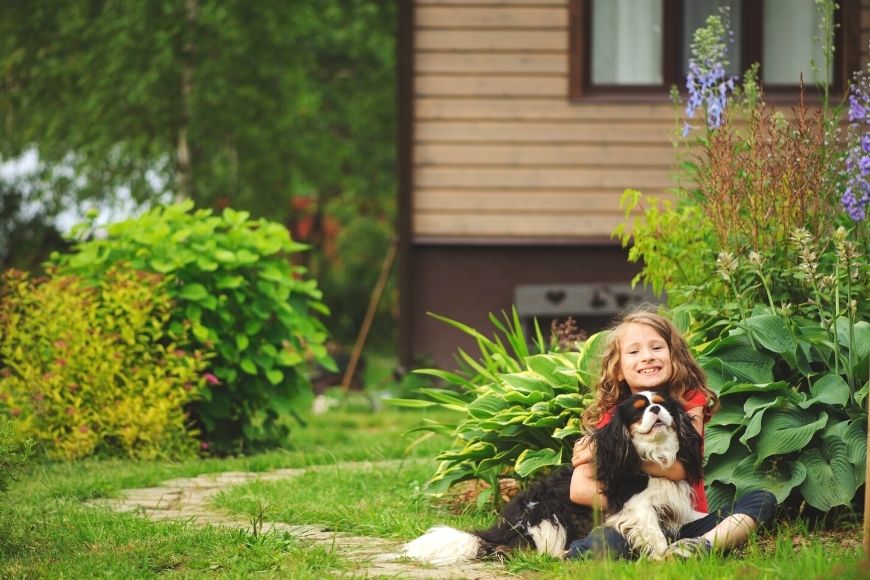
Pets and plants: so many gardeners love their four-legged friends and their botanical buddies, but at times, the two struggle to get along.
Between plants that are potentially dangerous to pets and sharp gardening tools, it can seem difficult to maintain a pet-friendly yard. However, with a bit of insight, pet-safe plants, and pet-smart garden design, your yard can be a paradise for you and your pets.
Designing Your Garden Layout with Your Pets In Mind
When establishing your gardens, you want to plan ahead and create a pet-smart layout. If you don’t plan ahead, you may find that your dog doesn’t have enough room to run and play or your cat has made it a habit to scale a tree up and over your fence.
To avoid these pitfalls and to prevent your flowers from being trampled by an overly excited pet, keep these tips in mind:
- The areas around your doors are going to be high traffic spots. Don’t plant fragile plants in their immediate vicinity or block your pet from getting to open grass. Instead, plant hardy and durable groundcovers that can hold up to being stepped on.
- Keep thorns and spines in areas your pet cannot go. The last thing you want is to find your pomeranian tangled in your Knock Out Roses.
- Avoid plants that generate tag-alongs or hitchhikers. These can be a pain to brush out of your pet’s coat.
- Provide shade and a place for your pet to lie comfortably. Keep in mind that some pets will want to bask in the sun for a bit before moving into the shade.
- Keep your bird feeders out of your cat’s sight…. We don’t think this one requires an explanation. Using squirrel-proof bird feeders can reduce the risk that your dog will chase away wildlife as well.
- Place birdhouses in areas your cat cannot access.
- Create garden paths to prevent your pets from walking over and on your plants.
- Add heavy, durable containers for variety and to avoid potted plant mishaps.
- Utilize garden fencing, raised beds, and borders to create “no-go zones.”
- Create a designated place for your pet’s water bowl.
Choose Pet-Friendly Plants and Avoid the Poisonous Ones
Equally as important as your garden’s layout when it comes to a pet-friendly paradise, is what plants you include in your landscape. Choosing the wrong plants could be disastrous. Some toxic plants can send your pet to the vet. Others will result in a bad case of vomiting and diarrhea.
The Most Poisonous Plants That Pet Owners Should Plant Carefully
- Lilies
- Sago Palms
- Azaleas
- Castor Bean
- Oleander
- Yew
- Aloe
- English Ivy
- Amaryllis
- Gladiolas
Of course, you always want to thoughtfully place plants that have spines or thorns such as cacti or roses. Most pet owners will also want to watch for any shrubs with sharp foliage like leather leaf mahonia and many holly varieties.
We know that eliminating choices in plants isn’t exactly helpful when it comes to narrowing down which should be included in your garden. So, we’ve created a list of plants that will hold up to your pet’s paws and are harmless if ingested.
Opt for some of these pet-safe, lush, and lovely plants:
- The winter-blooming Camellia
- Bright and cheerful marigolds
- Fuchsia in a container since it will likely need to be brought in for winter
- A ravishing magnolia in bush or tree form
- Shade-loving coral bells
- Tall and colorful snapdragons
- A hummingbird favorite: crape myrtle
- The bee-pleasing bee balm
- A colorful and durable ground cover: creeping thyme
- An all-around favorite that’s durable, native, bright, and pollinator-friendly: coreopsis
In the Habit of Pet-Friendly Gardening Practices
You want your yard to be a setting you and your pets can enjoy. To keep your yard as pet-friendly as possible, use pet-friendly practices as you work to maintain the beauty of your flowers, the health of your veggies, and the tidiness of your garden beds. Some of these practices should include:
- Never leave sharp gardening tools where your pet plays or has access.
- Always store all fertilizers and pesticides out of reach.
- Use organic plant foods, fungicides, herbicides, and pesticides.
- Supervise your pet whenever they’re in your yard.
- Check your fence occasionally to ensure it hasn't developed any weak spots or areas your pet could slip under.
Protect your pet’s health, safety, and happiness with a pet-friendly yard! Both you and your pet deserve a lush, luxurious, safe yard. With a few modifications and a bit of planning, you can create the pet-friendly paradise you and your pet are dreaming of.
Stick to non-toxic plants, design beds with walking paths, and use barriers to prevent your pet from accessing any fragile plants. Remember that durable ground covers can hold up to paws and play and don’t forget to put your gardening tools away.
Want to create more time for playing fetch with your dog or butterfly watching with your cat? Learn more about easy to grow flowers that will return after winter.
